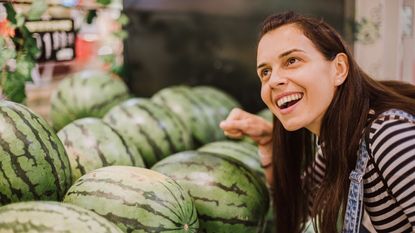How To Pick A Watermelon That Is Perfectly Ripe
Pick the the ripest watermelon from the bunch every time.


The watermelon is inarguably the perfect summer food, yet everyone has a differing opinion on how to pick out a ripe watermelon. Unlike other fruit, the color, aroma and feel are not indicators of watermelon ripeness – but what is? How do you know if a watermelon is ripe? Do you thump it, heft it, what? We’ve got the answers. Keep reading to learn how to pick a sweet watermelon that everyone can agree on.
How to Pick a Good Watermelon
Almost everyone loves the delicious, nutritious watermelon, but we seem to be at odds as to how to pick the perfect one out. Everyone has an opinion but who’s right? Depending on how many people you ask, there are probably as many answers to how to pick a watermelon as there are slices of this juicy fruit.
1. Buy from a Trusted Source
Unlike other fruit, watermelon does not ripen after it has been plucked from the vine. That means that hopefully, whoever you buy it from has picked the melon at its peak. From the supermarket to the farmer’s market, watermelons are picked when they are ripe and ready to eat. However, some are better than others.
2. Look for a Large, Round Fruit
Yes, watermelons are generally large and roundish, but you’re looking for the one that is more round than oval with no obvious irregularities and is big. The larger watermelons of the same shipment will have had the most time on the vine, so they will be the ripest.
3. Choose One with a Duller Rind
Believe it or not, the best melons will not be the prettiest. Instead, they will have a dull overall appearance. Shiny, bright green watermelons are actually underripe.
4. Find the Field Spot
Along with not being the most attractive melon, there is a major blemish you should look for. Look for the “field spot,” a large yellow area on one side of the melon. This is where the melon rested in the field as it grew. If the watermelon is ripe, the field spot will be more of a creamy, buttery yellow. The larger the field spot and the lighter the yellow hue, the longer the watermelon ripened on the vine.
5. Feel Its Weight
Bigger isn’t always better, but in the case of the best watermelon, it’s true. Pick up several melons to test them before choosing. You’re looking for the melon that feels heavier than it looks. The denser the melon compared to its size, the higher the water content, thus the juicier the melon.
Gardening tips, videos, info and more delivered right to your inbox!
Sign up for the Gardening Know How newsletter today and receive a free download of our most popular eBook "How to Grow Delicious Tomatoes."
6. Look for the “Sugar Bumps”
Again, the sweetest watermelon isn’t going to win a beauty contest. Look for melons that have extensive webbing or small spots of what looks like dirt. These spots are called sugar spots or bumps and are the pollination points where sugar seeps out of the fruit. A melon with these blemishes means it’s a sweet melon.
7. Give It a Thump for Good Measure
We’ve probably all heard about thumping a melon to see if it's ripe but is it true? Well, it can’t hurt. When knocked on, a ripe watermelon should make a deep, hollow sound. When not ripe, the sound is higher in pitch and denser.
Other Ways to Tell if a Watermelon is Ripe
Supposedly the striping on a ripe watermelon is another tell-tale sign of ripeness. The striping should be obvious, with green bands alternating dark green to light.
Also, if your melon still has a stem, the stem should be dry and light brown if it is ripe. This seems a bit suspect however, because it may just be an indication of how long it's been since it was picked.
Perhaps the best indicator of ripeness and sweetness is to pick your watermelon when it is in season. All fruits and vegetables have a natural season and in the case of watermelon, your best bet is from May to September.

Amy Grant has been gardening for 30 years and writing for 15. A professional chef and caterer, Amy's area of expertise is culinary gardening.
-
 Types Of Peonies Every Gardener Should Know
Types Of Peonies Every Gardener Should KnowKnowing the different types of peonies helps when you want your garden to include these fabulous plants. Showy and always impressive, peonies are an elegant addition.
By Bonnie L. Grant
-
 7 Sustainable Trends All Gardeners Should Take From The UK's Chelsea Flower Show
7 Sustainable Trends All Gardeners Should Take From The UK's Chelsea Flower ShowThe RHS Chelsea Flower Show 2024 is championing sustainability, with a focus on water conservation and creating resilient landscaping schemes in the face of climate change. Discover the key ideas to take away for your own garden.
By Melanie Griffiths